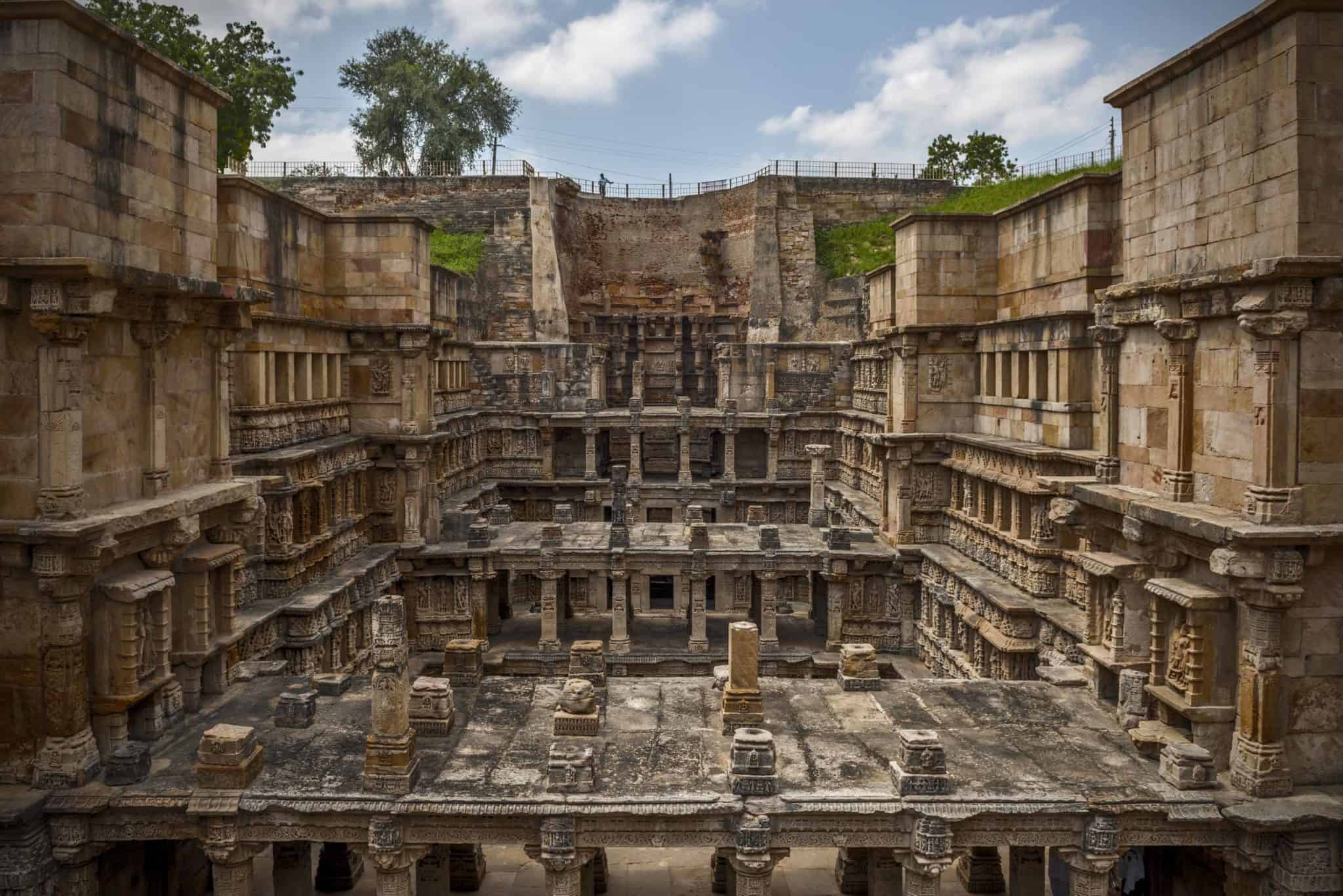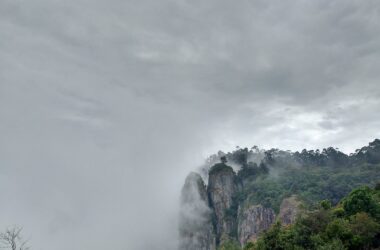Rani-ki-Vav or Rani ki Bawdi is one of the many UNESCO World Heritage Sites, home to the state of Gujarat. Situated on the banks of the Saraswati River, this stunning architectural marvel was built by Queen Udayamati in memory of her husband, King Bhima I, of the Chalukya or Solanki dynasty (950–1300 CE).
A fine specimen of the Maru-Gurjara style of architecture, UNESCO describes Bawdi as “the height of the artisans’ ability in Bawdi construction”. It is designed as an inverted temple and is divided into seven levels connected by staircases featuring tiled panels of unmatched artistic excellence. Of the seven, the fourth panel is the deepest and leads to a rectangular tank, measuring 9.5 meters by 9.4 meters, with a depth of 23 meters.
The structure has a total of 500 principle sculptures and more than a thousand small sculptures, depicting religious, mythological and secular imagery. Most of the idols are dedicated to Lord Vishnu, in various forms like Lord Rama, Lord Krishna, Lord Narasimha, Lord Vamana etc.
The stepwell is believed to have gone underground due to a severe flood in the Saraswati river, which used to flow nearby. It was revived after decades of laborious restoration by the Archaeological Survey of India (ASI) from the late 1980s.
EVERY STEP TELLS A STORY
Facts
- Rani ki Vav, or Rani ki Bawdi, is one of the many UNESCO World Heritage Sites, whose Gujarat state is home.
- It was built by Queen Udayamati in memory of her husband, King Bhima I of the Chalukya or Solanki dynasty, which existed between 950 and 1300 CE. Rani ki Vav is situated on the banks of Saraswati river.
- A fine specimen of the Maru-Gurjara style of architecture, UNESCO describes Rani-ki-Vav as exhibiting the pinnacle of craftsmanship in the construction of the stepwell. It is designed as an inverted temple and is divided into seven tiers, with sculptural panels of unmatched artistic quality.
- A flight of stairs made in different geometric patterns leads the visitors to Rani ki Vav. Several stone columns can also be seen at the end of the stairs.
- The new hundred rupee note issued by the Reserve Bank of India features Rani-ki-Vav.
- Rani ki Vav is the fourth deepest of the seven levels and leads to a rectangular tank measuring 9.5 m by 9.4 m at a depth of 23 m.
- Rani’s Vav Bawdi is believed to have been submerged underground due to severe floods in the Saraswati river. It was revived after decades of painstaking clearance and restoration by the Archaeological Survey of India since 1958.
- The Queen’s Vav World Heritage Site has 500 major sculptures and more than a thousand smaller statues, depicting religious, mythological and non-sacred images.
- Most of the idols in Rani ki Vav are in devotion to Lord Vishnu, in various forms like Lord Rama, Lord Krishna, Lord Narasimha and Lord Vamana.
- The walls of the various stories of the huge stepwell are adorned with intricately carved sculptures, while various sections of the stepwell are joined by beautifully carved columns.
- The pillars of Rani ki Vav are intricately carved with floral patterns and sculptures of various deities. Sculptures of women are carved in the upper part of the pillars in such a way that it seems as if their shoulders are supporting the roof.
- The stepwell is divided into several storeys which are supported by many intricately carved pillars. While the lower part of the columns are plain, their upper part is adorned with grand carvings. The pillars on either side of the pillared floors are decorated with mythological sculptures.
- The attractive statues of the queen’s Vava Bawdi are either inspired by various incarnations of Lord Vishnu, or depict the Apsaras – young celestial women.
- The walls of panels perpendicular to the Rani ki Vav rest on the basal course at fixed intervals. The sculptures adorning the walls include celestial women and incarnations of Lord Vishnu.
- The elaborately carved walls of Rani’s Vav Bawdi feature statues of celestial women and other mythological characters such as Nagakanya and Yogini. The central niches of the wall, one on top of the other, are adorned with sculptures that depict the infinite asana form of Lord Vishnu, among other incarnations. There are also rows of female deities in the walls.
Read about more heritage site
Frequently Asked Questions About Rani ki Vav
Q. Why is Rani ki Vav famous?
A – Rani ki Vav is considered to be the finest in Gujarat and the biggest example of the architecture of Bawdi. It was built at the height of the skill of the artisans in the stepwell construction and Maru-Gurjara architectural style, which reflects the mastery of this intricate technique and the beauty of detail and proportion.
Q. Who got Patan’s stepwell constructed?
A – In 1063, Queen Udayamati of the Chalukya dynasty built a stepwell in the memory of her husband, Bhimdev I. Jain monk, Merutunga’s 1304 composition mentions that Udaymati, daughter of Naravarah Khangara, built this stepwell at Patan.
Q. Rani ki Vav was created by which queen?
A – This stepwell was constructed by Queen Udayamati of Solanki dynasty as a memorial to her deceased husband Bhimdev I in the 11th century. Over the years, as the Saraswati River changed its course, the massive structure was flooded and buried until its excavation by the Department of Archeology survey of India in the late 1980s.
Q. How was Rani ki Vav discovered?
A – The stepwell was excavated by the Archaeological Survey of India in the late 1980s and was found to be in pristine condition.
Q. Who got the queen’s wav constructed?
A – Rani-ki-Vav (Queen’s stepwell) is situated on the banks of the Saraswati river and was initially built as a memorial to a king in the 11th century AD. Queen Udaymati built this stepwell in 1063 AD in memory of her husband Raja Bhimdev I of the Solanki dynasty.
Q. Which state is famous for stepwells ?
A – Stepwells were built in the southwestern region of Gujarat around 600 AD; From there they spread to Rajasthan in the north and later to north and west India.









